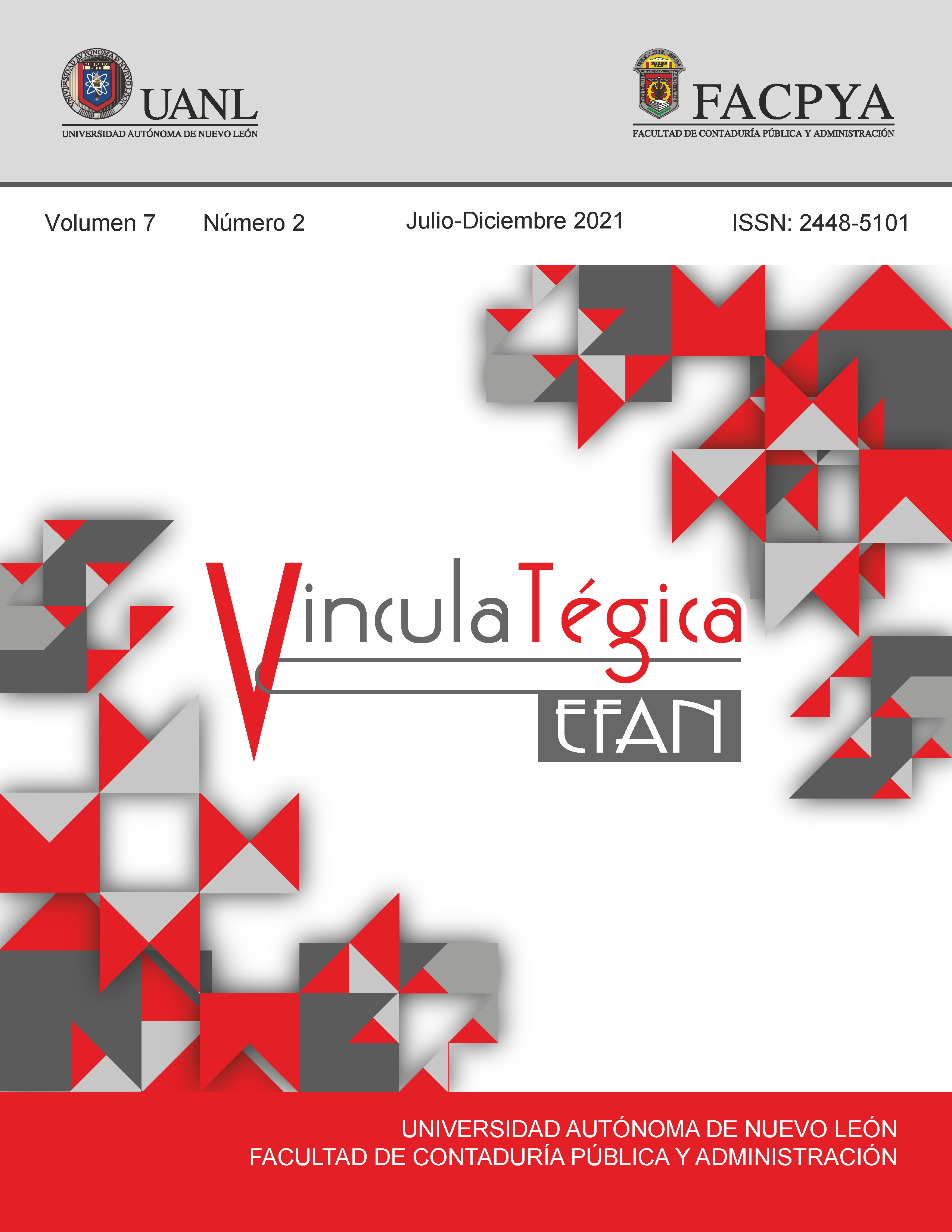Herramienta Teams: grado de satisfacción en ámbito socio-emocional, académico y administración del tiempo
DOI:
https://doi.org/10.29105/vtga7.1-89Keywords:
Aprendizaje, Microsoft Teams, Tecnología.Abstract
Se llevó esta investigación para conocer más acerca de la plataforma Microsoft Teams, su creación, fines generales de uso, ventajas, desventajas y tareas que brinda al usuario y también para conocer el inicio de las diversas plataformas que ahora tenemos al alcance de nuestras manos para seguir en contacto con compañeros de trabajo, maestros, alumnos, etc. y de esta manera seguir aprendiendo y trabajando seguros y desde cualquier lugar. Y se llevó a cabo una investigación de información en la base de datos PUBMED del año 2017 hasta el 2021 utilizando palabras clave. Se realizó también una encuesta en la cual participaron 515 estudiantes de la carrera de odontología de la Facultad de Odontología de la Universidad Autónoma de Nuevo León. Los alumnos que emplean la plataforma virtual Microsoft Teams, se sienten en general satisfechos con la aplicación y con las tareas que esta plataforma brinda para que el alumno pueda llevar a cabo de mejor manera sus tareas y sacar el mayor provecho de sus clases.
Downloads
References
Al-Balas M, Al-Balas HI, Jaber HM, Obeidat K, Al-Balas H, Aborajooh EA, Al-Taher R, Al-Balas B. (2020) .Distance learning in clinical medical education amid COVID-19 pandemic in Jordan: current situation, challenges, and perspectives. BMC Med Educ. 2;20(1):341. DOI: https://doi.org/10.1186/s12909-020-02257-4
Arrieta M, Aguas R, Villegas E, Buelvas K.(2019). Convergencia de procesos de docencia universitaria: El uso de la aplicación Teams de Microsoft. Researchgate.
Artopoulos, A., Huarte, J., Rivoir, A.(2020)Plataformas de simulación y aprendizaje. Propuesta Educativa.; 29:53.25 a 44.
Baticulon RE, Sy JJ, Alberto NRI, Baron MBC, Mabulay REC, Rizada LGT, Tiu CJS, Clarion CA, Reyes JCB(2021). Barriers to Online Learning in the Time of COVID-19: A National Survey of Medical Students in the Philippines. Med Sci Educ. 24:1-12. DOI: https://doi.org/10.1101/2020.07.16.20155747
Cassum S, Mansoor K, Hirji A, David A, Aijaz A.(2020). Challenges in Teaching Palliative Care Module Virtually during COVID-19 Era. Asia Pac J Oncol Nurs.14;7(4):301-304. DOI: https://doi.org/10.4103/apjon.apjon_42_20
Castellano Gil, José M, Coronel Brito, Paola A y Quintero, Gisela(2020). La mirada de los estudiantes de la universidad nacional de educación en Ecuador sobre la educación en tiempos de Covid-19. Conrado.6(76), 325-332. DOI: https://doi.org/10.29394/Scientific.issn.2542-2987.2021.6.19.9.185-207
Castro. M., Castro. A., Hernandez. V.(2017) Análisis de plataformas educativas digitales comerciales españolas destinadas a educación primaria. Rev. Lat de tec ed.;16:2.50-62.
Cross CE, Robinson C, Todd E. (2020).evelopment and Implementation of a Synchronous Online TBL Using Microsoft Forms. Med Sci Educ.: 24:1-3. DOI: https://doi.org/10.1007/s40670-020-01133-6
Dans, E.(2009). Educación online: plataformas educativas y el dilema de la apertura. Rev de Unity y Soc del Conoc.;6:1.22-29
Dost S, Hossain A, Shehab M, Abdelwahed A(2020). Al-Nusair L. Perceptions of medical students towards online teaching during the COVID-19 pandemic: a national cross-sectional survey of 2721 UK medical students. BMJ Open. 5;10(11):e042378. DOI: https://doi.org/10.1136/bmjopen-2020-042378
Haras C, Calhoun A, Olson AP, Rosenberg M.(2021). Mindful Medical Education Online. Med Sci Educ. 4:1-10 DOI: https://doi.org/10.1007/s40670-021-01253-7
Henderson D, Woodcock H, Mehta J, Khan N, Shivji V, Richardson C, Aya H, Ziser S, Pollara G, Burns A.(2020) Keep calm and carry on learning: using Microsoft Teams to deliver a medical education programme during the COVID-19 pandemic. Future Healthc J;7(3):e67-e70 DOI: https://doi.org/10.7861/fhj.2020-0071
Higgins R, Murphy F, Hogg P.(2020).The impact of teaching experimental research on-line: Research-informed teaching and COVID-19. Radiography (Lond). DOI: https://doi.org/10.1016/j.radi.2020.11.014
Innerarity, D.(2020)Una teoría de la democracia compleja: gobernar en el siglo XXI. Barcelona: Galaxia Gutenberg.
Kirkup Gill y Kirkwood Adrian (2005) Tecnologías de la información y las comunicaciones (TIC) en la enseñanza de la educación superior: una historia de gradualismo en lugar de revolución, Aprendizaje, medios y tecnología, 30: 2, 185-199
Knox, J.(2019). What Does the ‘Postdigital’ Mean for Education? Three Critical Perspectives on the Digital, with Implications for Educational Research and Practice. Postdigital Science and Education.1:357-370. DOI: https://doi.org/10.1007/s42438-019-00045-y
Kochar A, Rymer J, Samad Z.(2018). Duke Cardiovascular Education Group. Disrupting Fellow Education Through Group Texting: WhatsApp in Fellow Education? J Am Coll Cardiol.;72(25):3366-3369. DOI: https://doi.org/10.1016/j.jacc.2018.11.007
Lansmann S., Schallenmüller S., Rigby (2020)M. Teams Everywhere–Investigating the Impact of Microsoft Teams on Knowledge Worker. Research gate.
Pal D, Vanijja V.(2020)Perceived usability evaluation of Microsoft Teams as an online learning platform during COVID-19 using system usability scale and technology acceptance model in India. Child Youth Serv Rev. DOI: https://doi.org/10.1016/j.childyouth.2020.105535
Parkes RSV, Barrs VRD(2021) Interaction Identified as both a Challenge and a Benefit in a Rapid Switch to Online Teaching during the COVID-19 Pandemic. J Vet Med Educ. DOI: https://doi.org/10.3138/jvme-2020-0063
Panigrahi R., Srivastava PR, Sharma D.(2018). Aprendizaje en línea: adopción, continuación y resultado del aprendizaje: una revisión de la literatura. Revista Internacional de Gestión de la Información.; 43 : 1-14.
Rehman R, Fatima SS.(2021) An innovation in Flipped Class Room: A teaching model to facilitate synchronous and asynchronous learning during a pandemic. Pak J Med Sci. DOI: https://doi.org/10.12669/pjms.37.1.3096
Reshef O, Aharonovich I, Armani AM, Gigan S, Grange R, Kats MA, Sapienza R.(2020) How to organize an online conference. Nat Rev Mater. 18:1-4. DOI: https://doi.org/10.1038/s41578-020-0194-0
Santiago, R. y Bergmann, J.(2019). Aprender al revés: flipped learning 3.0 y metodologías activas en el aula. Barcelona: Paidós.
Sawarkar G, Sawarkar P, Kuchewar V.(2020) Ayurveda students' perception toward online learning during the COVID-19 pandemic. J Educ Health Promot. DOI: https://doi.org/10.4103/jehp.jehp_558_20
Singhi EK, Dupuis MM, Ross JA, Rieber AG, Bhadkamkar NA(2020). Medical Hematology/Oncology Fellows' Perceptions of Online Medical Education During the COVID-19 Pandemic. J Cancer Educ.;35(5):1034-1040. DOI: https://doi.org/10.1007/s13187-020-01863-6
Skrzypek A, Perera I, Szeliga M, Cebula G.(2020).Modification of teaching during the COVID-19 pandemic at the Department of Medical Education of Jagiellonian University Medical College. Folia Med Cracovia.60(4):113-121.
Trowbridge T, McDaniel T, Shafi B, Copeland C.(2021)Use of Microsoft Teams private channels for in-person small group hands-on instruction during COVID-19 social distancing requirements. J Dent Educ:15:10.1002 DOI: https://doi.org/10.1002/jdd.12539
Tuma F, Nituica C, Mansuri O, Kamel MK, McKenna J, Blebea J.(2021) The academic experience in distance (virtual) rounding and education of emergency surgery during COVID-19 pandemic.:15 DOI: https://doi.org/10.1016/j.sopen.2021.03.001
Valverde, Juan Carlos, Romero-Zúñiga, Mariela, y Vargas-Fonseca, Lupita(2020). Tendencias actuales, retos y oportunidades de los procesos de aprendizaje universitario aplicados a las Ciencias Forestales. Revista científica.:39:262-277 DOI: https://doi.org/10.14483/23448350.16030
Wilcha RJ.(2020). Effectiveness of Virtual Medical Teaching During the COVID-19 Crisis: Systematic Review. JMIR Med Educ.;6(2):e20963. DOI: https://doi.org/10.2196/20963
Wayne DB, Green M, Neilson EG.(2020) Medical education in the time of COVID-19. Sci Adv.;6(31):eabc7110. DOI: https://doi.org/10.1126/sciadv.abc7110
Yang YT, Silverman RD.(2015).Social distancing and the unvaccinated. N Engl J Med.16;372(16):1481-3. DOI: https://doi.org/10.1056/NEJMp1501198
Downloads
Published
How to Cite
Issue
Section
License

This work is licensed under a Creative Commons Attribution 4.0 International License.
a). Authors keep copyright and give the journal the right of the first publication of the work under a Creative Commons attribution license. This license allows others to share the work as long as original authorship and initial publication in this journal is acknowledged.
b). Authors may make other independent and additional contractual agreements for the non-exclusive distribution of the version of the article published in this journal (e.g., include it in an institutional repository or publish it in a book) as long as they clearly indicate that the work was published for the first time in this journal.







